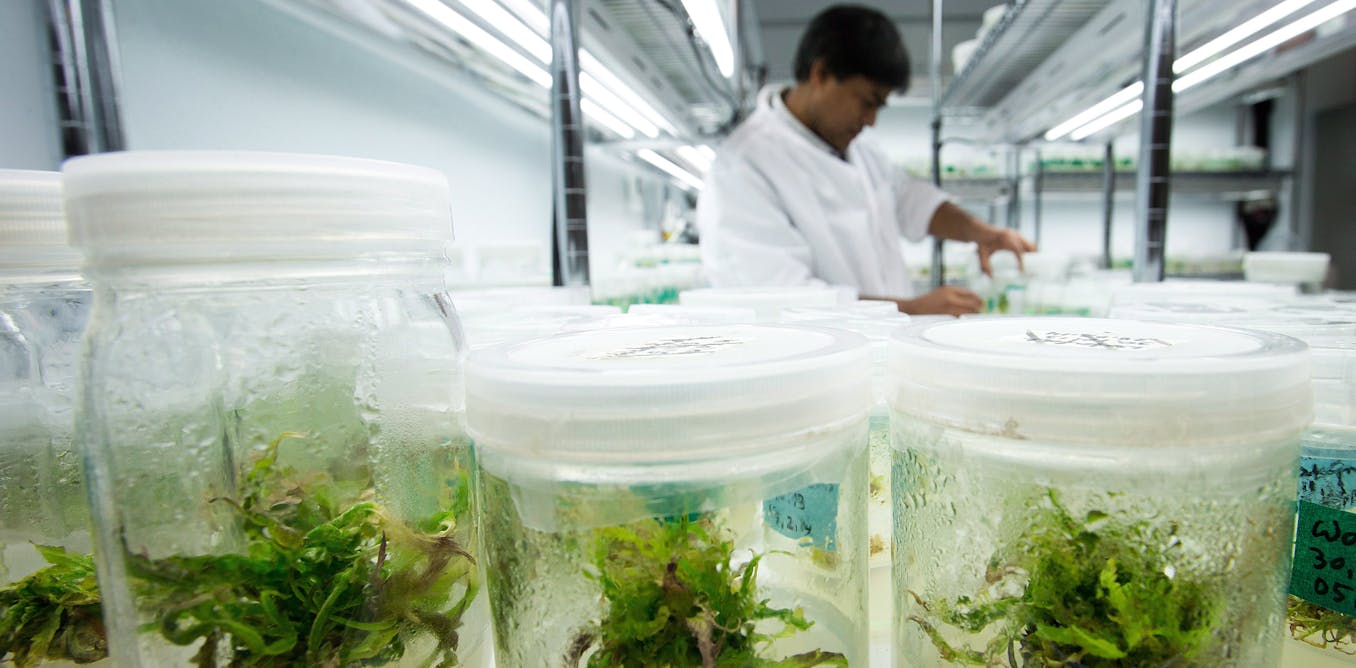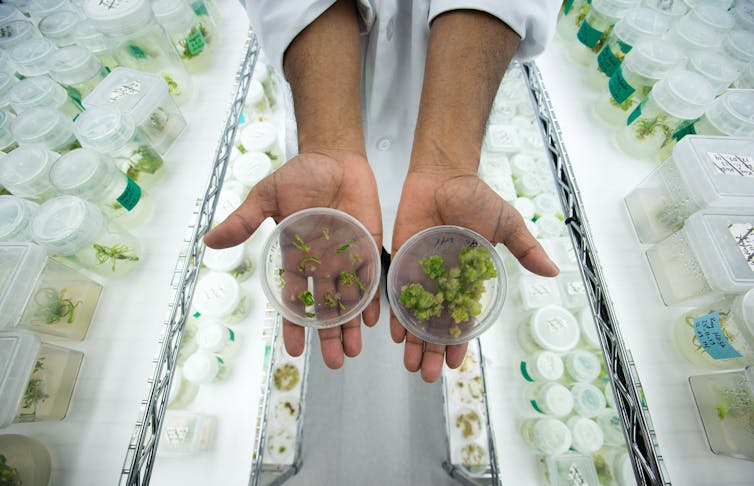
Cannabis plant strains in jars in MediJean’s Health Canada-licensed tissue culture development lab are kept for research as manager Abdul Ahad works in the Richmond, B.C., facility, in this 2014 file photo. (THE CANADIAN PRESS/Darryl Dyck)
In Canada and around the world, legal cannabis producers face many challenges: Varying government regulations, high security requirements and a lack of reliable information on how to grow their crops.
Growing cannabis has been illegal for so many years that scientific research on how to best produce this crop is limited. Much of the knowledge on how to grow cannabis lacks validation, is clouded in secrecy and is mostly connected to hidden and illegal production facilities of the past.
In contrast, researchers have been improving production practices for other crops, including medicinal plants, for decades, creating a large body of scientificaly-validated information.
With changing government regulations in Canada, and the many medicinal benefits of cannabis, it is time to move the legal cannabis plant production industry into the realm of high-tech laboratories and scientific practices.
We must sift through accumulated grower knowledge, while publicly documenting and improving production practices. Evidence-based research will help growers produce more consistent, high-yielding and high-quality products and help inform policy makers as they regulate this industry.
As researchers who study how to produce high-value plants (e.g. medicinal, nutraceutical, edible and ornamental plants) under controlled environments — including indoor medical cannabis — we believe this will require collaborative research among cannabis growers and researchers.
Our lab at the University of Guelph is one of the best in the world for horticulture research, particularly for controlled-environment plant production. In recent years, we have been applying this knowledge to our collaborations with legal cannabis growers. With legalized recreational cannabis use on the horizon in Canada, more licensed growers are seeking this sort of expertise.
Current state of cannabis production
Growing cannabis can be a lucrative business. Spending on legal cannabis in North American medicinal and recreational markets is projected to reach US$21.6 billion by 2021.
In Canada, there are currently 73 authorized licensed medical cannabis producers, most of them large-scale producers. With the recreational use and sale of cannabis scheduled for legalization in our country next year, it is foreseeable that many more large-scale producers will enter the market.
In the past, indoor cannabis production was largely confined to smaller-scale operations. Under these conditions, growers accumulated enormous levels of knowledge and experience. But much was kept as trade secrets and most still needs to be scientifically validated.
Even in today’s modern medicinal cannabis production facilities, growers are often reliant on online forums — so-called “grow guides” — and advice from salespeople for information on crop production. Without proper training, it can be hard to tell fact from fiction.

Looking to decades of horticultural knowledge
Humans have been growing plants in controlled environments for hundreds of years. Over the past 50 years, billions of dollars have been invested into this research field and an enormous amount of knowledge has been accumulated. Cannabis producers can dip into this knowledge pool by working with skilled researchers.
The production challenges facing large-scale cannabis producers will inevitably be like those producing other greenhouse crops, especially issues with nutrient and disease management. For example, large-scale plant production facilities use large quantities of fertilizers and water. If improperly disposed of, they could pollute the surrounding environment.
Growers may also decide to reuse their nutrient solution, but doing so risks spreading pathogens from one infected plant to the whole operation. Through collaboration with horticultural scientists, large-scale producers will have access to many different technologies and strategies to treat irrigation water for reuse or discharge. This will help combat potential problems.
Another example involves artificial lighting for plants. In the past, most operations were using high pressure sodium (HPS) lamps as growing lights. HPS is not efficient in converting electricity to light for plant growth, and lighting is one of the major costs for indoor plant production.
Light emitting diode (LED) technology) is rapidly developing, with dramatic increases in energy efficiency and decreases in price. LEDs can provide different light colours and spectral combinations as needed. Research tells us that we can use light colour and intensity to steer plants to produce desired characteristics and chemical components. However, there is hardly any published scientific research on how to use this modern technology to produce high quality cannabis — information that cannabis growers certainly need.
Developing government policy
Public policy on cannabis has focused on public health concerns, the illegal market and taxation. With the opening of the recreational market and increased production, regulating production will also be important.
In the Canadian medicinal cannabis market, there are strictly enforced quality and safety regulations on products being distributed to patients. However, there is little guidance on production, other than to meet these standards. Governments will have to regulate production practices, with both producer and public interest in mind.
Unfortunately, reliable evidence-based research is lacking. As mentioned, the bulk of production knowledge is anecdotal and even secretive. It makes things difficult for policymakers charged with setting standards and policies.
Research efforts to scientifically improve, verify and document valuable knowledge on cannabis production will not only help growers, but also governments seeking to regulate and support this industry.
[“Source-theconversation”]















